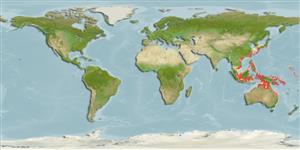Classification / Names
ชื่อสามัญ | ชื่อพ้อง | Catalog of Fishes(สกุล, ชนิด) | ITIS | CoL | WoRMS | Cloffa
>
Gobiiformes (Gobies) >
Gobiidae (Gobies) > Gobiinae
Etymology: papilio: Name from Latin 'papilio' meaning butterfly, used as the generic name of the swallowtail butterfly, refers to the elongate, filamentous fifth and ninth branched caudal-fin rays (like the 'tails' of the swallowtail butterfly); noun in apposition..
Environment: milieu / climate zone / depth range / distribution range
นิเวศวิทยา
เกี่ยวกับทะเล,น้ำเค็ม สัตว์น้ำหน้าดิน; ระดับความลึก 5 - 55 m (Ref. 90102). Temperate
Northwest Pacific: Ryukyu Is., Japan.
ขนาด / น้ำหนัก / Age
Maturity: Lm ? range ? - ? cm
Max length : 4.1 cm SL เพศผู้/กระเทย; (Ref. 55718)
Short description
สัณฐานวิทยา | ความยาวต่างๆ
เงี่ยงครีบหลัง (รวม): 7; ก้านครีบอ่อนที่หาง (รวม): 11; เงี่ยงครีบก้น 1; ก้านครีบอ่อนที่ก้น: 11; สัตว์มีกระดูกสันหลัง: 26. This species is distinguished from its congeners in having the following set of characters: segmented dorsal-fin rays 11; segmented anal-fin rays 11; longitudinal scales 27; predorsal scales 11; third spine of first dorsal fin elongate, filamentous, and longer than the other spines; fifth and ninth branched caudal-fin rays elongate, filamentous, and forming bifurcate caudal fin; fifth and ninth branched rays each with a single branch; cephalic sensory-papillae row 'a' with 3 widely spaced papillae; numerous small yellow spots scattered on cheek, operculum, nape, body, and dorsal fins in fresh or live individuals; below the eye is a dusky yellowish brown vertical bar; body with 4 dark gray brown saddles, in addition to a similarly colored large blotch at midlateral caudal-fin base (Ref. 55718).
A single specimen collected from a sandy-mud bottom at a depth of 45 m in a protected bay. Observed to be usually at 40-50 m depths (area with pebbles); the young at depths of 8 m to about 30 m, but apparently on rare occasions; the species symbiotically associates with alpheid shrimp (species name uncertain) (Ref. 55718).
Life cycle and mating behavior
วัยเจริญพันธุ์ | การสืบพันธุ์ | การวางไข่ | เซลสืบพันธ์ของเพศเมีย(ไข่) | ความดกของไข่ | ตัวอ่อน
Shibukawa, K. and T. Suzuki, 2004. Vanderhorstia papilio, a new shrimp-associated goby from the Ryukyu Islands, Japan (Perciformes: Gobiidae: Gobiinae), with comments on the limits of the genus. Ichthyol. Res. 51:113-119. (Ref. 55718)
IUCN Red List Status (Ref. 130435)
Threat to humans
Harmless
Human uses
ข้อมูลเพิ่มเติม
ชื่อสามัญชื่อพ้องกลไกการเผาผลาญพลังงานผู้ล่าการศึกษาเกี่ยวกับผลกระทบของสารประกอบทางเคมีที่เป็นอันตรายต่อสิ่งมีชีวิต ประชากร และสิ่งแวดล้อมการสืบพันธุ์วัยเจริญพันธุ์การวางไข่การรวมกลุ่มวางไข่ความดกของไข่เซลสืบพันธ์ของเพศเมีย(ไข่)Egg development
Age/SizeการเจริญเติบโตLength-weightLength-lengthLength-frequenciesความยาวต่างๆสัณฐานวิทยาตัวอ่อนพลวัตของสัตว์น้ำวัยอ่อนการทดแทนที่อุดมสมบรูณ์BRUVS
อ้างอิงการเพาะเลี้ยงสัตว์น้ำประวัติการเพาะเลี้ยงสัตว์น้ำสายพันธุ์พันธุศาสตร์ElectrophoresesอัตราพันธุกรรมโรคการแปรรูปNutrientsMass conversion
ผู้ร่วมมือรูปภาพหลายรูปStamps, Coins Misc.เสียงปลามีพิษ เช่น ปลาปักเป้าความเร็วรูปแบบการว่ายน้ำพื้นที่เหงือกOtolithsสมองวิสัยทัศน์
เครื่องมือ
Special reports
Download XML
แหล่งที่มาจากอินเตอร์เน็ต
Estimates based on models
Preferred temperature (Ref.
123201): 23.6 - 28.9, mean 27.9 °C (based on 202 cells).
Phylogenetic diversity index (Ref.
82804): PD
50 = 0.5000 [Uniqueness, from 0.5 = low to 2.0 = high].
Bayesian length-weight: a=0.00708 (0.00333 - 0.01504), b=3.09 (2.92 - 3.26), in cm total length, based on LWR estimates for this (Sub)family-body shape (Ref.
93245).
ระดับชั้นอาหาร (Ref.
69278): 3.2 ±0.3 se; based on size and trophs of closest relatives
ความสามารถในการกลับคืนสู่ปกติ (Ref.
120179): ความสูง, เวลาต่ำสุดที่จะทำให้ประชากรเพิ่มขึ้นเป็น 2 เท่าใช้เวลาน้อยกว่า 15 เดือน (Preliminary K or Fecundity.).
Fishing Vulnerability (Ref.
59153): Low vulnerability (10 of 100).
